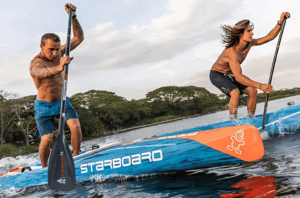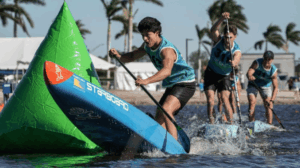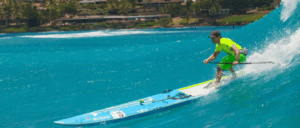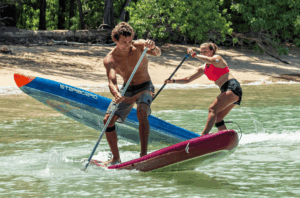When most people picture stand-up paddleboarding (SUP), they think of a casual cruise across a glassy lake or a peaceful morning practice in calm ocean bays. But hidden behind the serene reputation of SUP lies a fast-growing, adrenaline-fueled sport that’s gaining serious traction worldwide: SUP Racing.
Over the past decade, SUP racing has evolved from a fringe pastime into a respected competitive sport with professional athletes, international championships, and a dedicated global community. If you’ve ever wondered what it’s like to push your body, mind, and board to the limit, SUP racing might just be your next obsession.
What Exactly Is SUP Racing?
At its simplest, SUP racing is a race on stand-up paddleboards over a designated course. But within that simplicity lies a wide variety:
- Short course races (sometimes under 5 kilometers) prioritize sprinting power, agility, and sharp corner turns.
- Distance races (ranging from 10 kilometers to marathon-length and beyond) demand endurance, pacing, and mental toughness.
- Technical races combine flatwater sprints with buoy turns, surf navigation, and even beach runs where athletes must carry their boards.
Competitions take place on lakes, rivers, and oceans, with conditions varying from mirror-flat surfaces to roaring surf and gusty winds. Athletes must adapt not only to their opponents but to the ever-changing environment, making every race a uniquely challenging experience.
The Physical Demands Of SUP Racing
At a glance, paddleboarding might seem easy enough. But anyone who’s trained seriously for a SUP race knows otherwise. Racing demands a rare combination of attributes:
- Cardiovascular endurance: To maintain a steady paddling rhythm for races that can last over an hour – or several.

- Explosive power: Especially critical for sprint starts, buoy turns, and final finishes.
- Balance and stability: Even in choppy, unpredictable water.
- Upper body strength and range of motion: Particularly in the shoulders, back, and arms for efficient strokes.
- Core and leg strength: To stabilize the body, transfer power through the paddle, and maintain optimal form over time.
SUP racers often cross-train with running, swimming, rowing, and strength work to build a body capable of handling the unpredictable stresses of the sport. Functional fitness reigns supreme here – raw muscle mass won’t help much if you can’t stabilize it against waves or wind.
Strategy Matters More Than You Think
SUP racing isn’t just a brute physical contest; it’s a game of strategy as well. Drafting (paddling closely behind another competitor to reduce water resistance) can create huge energy savings over longer distances, much like drafting in cycling. Reading the water – spotting currents, anticipating wave sets, and picking the best lines – is a key tactical advantage.
 Buoy turns are another critical moment. Sharp, efficient turns can gain or lose valuable meters. Beach starts and finishes, where competitors must sprint through shallow water or soft sand carrying their boards, often decide races by mere seconds.
Buoy turns are another critical moment. Sharp, efficient turns can gain or lose valuable meters. Beach starts and finishes, where competitors must sprint through shallow water or soft sand carrying their boards, often decide races by mere seconds.
In technical races, especially, mental adaptability is just as important as physical readiness. One bad wave, one missed draft, one awkward fall – and you can tumble from first to fifth in an instant.
Gear: It’s Not Just A Board And Paddle
While casual paddlers can get away with all-purpose boards, serious racers obsess over their equipment. Racing boards are lighter, narrower, and longer than recreational SUPs – typically between 12’6” and 14’ long, and as narrow as 20 inches. These specs reduce drag and increase speed, but demand significantly better balance.
Paddles, too, are optimized: lightweight carbon fiber models with carefully designed blade shapes for maximum efficiency and minimal fatigue.
Many racers also invest in:
- Hydration packs for long-distance races.
- Compression gear to support muscle recovery.
- Specialty leashes that won’t trip them up during surf entries and exits.
In high-level competition, having the right board and paddle setup can make the difference between making the podium or paddling in alone behind the pack.

Where SUP Racing Is Headed
The sport has exploded globally, with flagship events like:
- The Carolina Cup (USA)
- The Pacific Paddle Games (USA) – which has been discontinued for now with the sale of SUP The Mag
- The SUP 11-City Tour (Netherlands)
- The ISA World SUP and Paddleboard Championship (rotating international locations)
In 2019, there was even a push to include SUP racing in the Olympics under the governance of the International Surfing Association (ISA), though disputes with the International Canoe Federation (ICF) complicated those efforts. Nonetheless, the international recognition of SUP as a serious competitive sport is only growing.
Grassroots events are flourishing too, with local race leagues popping up in coastal towns, lakeside communities, and even urban rivers. From Hawaii to Holland, amateur racers are hitting the water in record numbers, chasing personal bests, community camaraderie, and that irreplaceable rush of crossing the finish line under their own power.
Why SUP Racing Appeals To So Many Athletes
Beyond the pure competitive drive, SUP racing offers something rare in modern sports: an intimate connection with nature. Racers must learn to work with the water, not against it. Conditions are never perfectly controlled – there are no climate-controlled stadiums, no artificial turf, no replay reviews. Just you, your board, the paddle, the weather, and the water.
modern sports: an intimate connection with nature. Racers must learn to work with the water, not against it. Conditions are never perfectly controlled – there are no climate-controlled stadiums, no artificial turf, no replay reviews. Just you, your board, the paddle, the weather, and the water.
This rawness gives SUP racing a sense of purity. It rewards physical and mental resilience, of course, but it also fosters deep humility. No matter how well you train, Mother Nature will always have the final say.
SUP racing also offers broad accessibility. While high-end boards and gear can be pricey, many communities host events where beginners can rent equipment and join beginner-friendly divisions. Athletes of all ages compete – even kids’ and seniors’ divisions are commonplace. There’s a strong spirit of encouragement, growth, and mentorship within the sport.
How To Get Started
If you’re feeling intrigued (or fired up), getting into SUP racing is easier than you might think:
- Find a local paddle group or race league. Many communities host informal races and clinics.
- Rent or borrow gear. There’s no need to buy a $2000 carbon board right away – try out a few options first.
- Start practicing your technique. Focus on efficiency over brute strength: smooth, clean strokes, stable stance, and balanced breathing.
- Train both on and off the water. Cross-training with running, strength training, and mobility work pays huge dividends.
- Sign up for a beginner race! You don’t need to be fast to race – you just need to show up, give it your best, and learn.
Final Thoughts
SUP racing offers one of the most unique blends of athleticism, strategy, and water adventure in the sports world today. It’s fast. It’s demanding. It’s humbling. It’s exhilarating. Whether you’re chasing a podium finish or simply pushing your personal limits, SUP racing connects you with your environment – and with yourself – in ways few sports can match.
So next time you see someone gliding across the water on a paddleboard, look closer. They might not just be cruising – they might be training for battle.
Because in SUP racing, you don’t just race the clock – you race the elements themselves.








